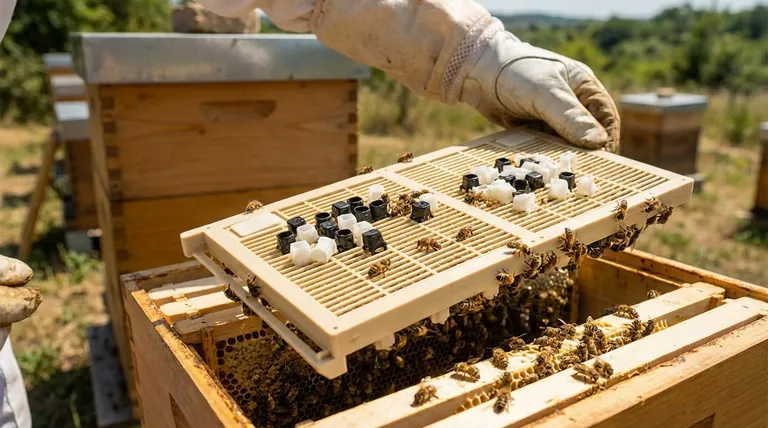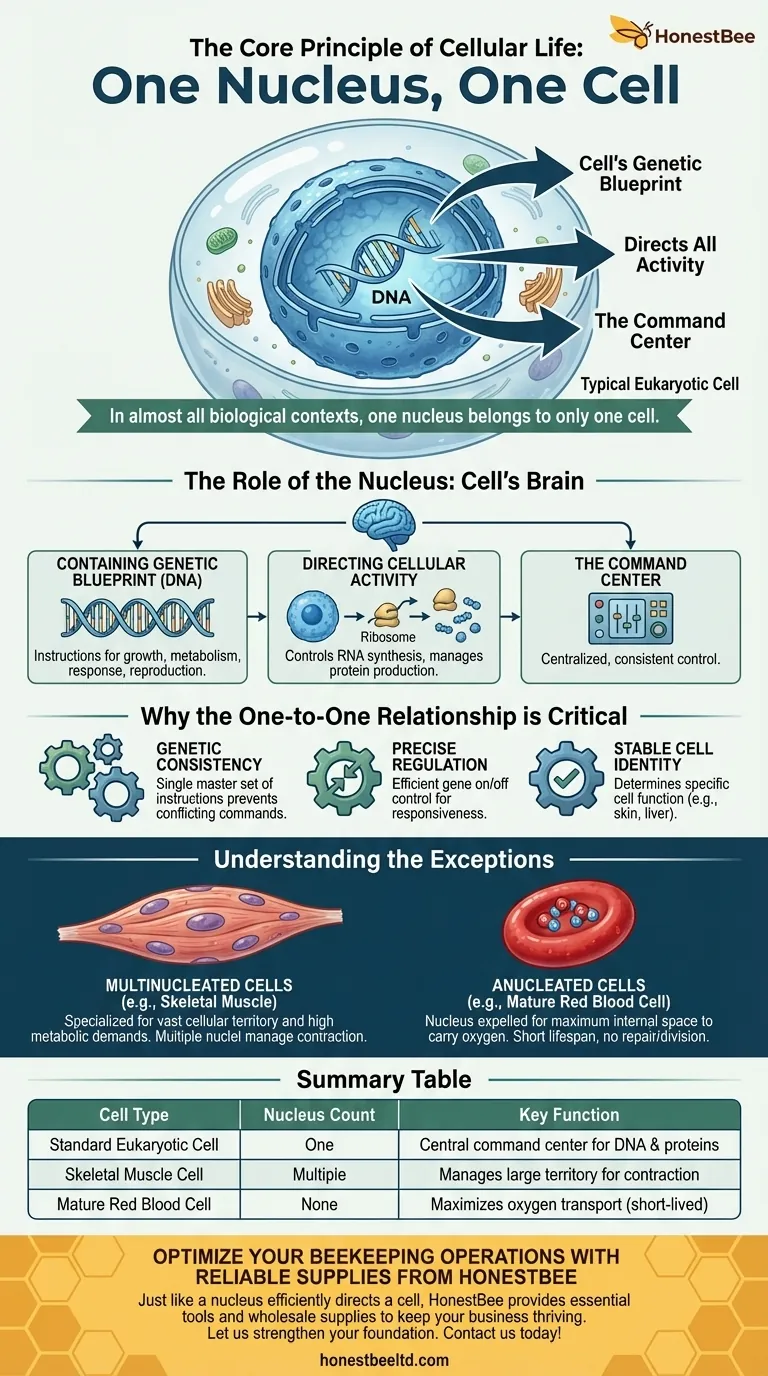In almost all biological contexts, one nucleus belongs to only one cell. The nucleus is not an independent entity given to a cell; rather, it is the essential command center that contains the cell's genetic blueprint (DNA) and directs all of its activities, making this one-to-one relationship fundamental to life.
The core principle to grasp is that a eukaryotic cell is defined by its nucleus. The relationship isn't one of assignment but of integration—the nucleus is the core organelle that governs a single cell's function, identity, and future.

The Role of the Nucleus as the Cell's Brain
To understand why the one-nucleus-per-cell rule is standard, you must first understand the nucleus's function. It isn't a passive passenger; it is the most critical organelle for complex cells.
The Command Center
Think of the nucleus as the central headquarters or brain of the cell. It is a large, membrane-bound organelle that houses and protects the cell's most valuable asset.
Containing the Genetic Blueprint
That asset is the cell's DNA (deoxyribonucleic acid). The DNA contains all the instructions needed for the cell to grow, metabolize nutrients, respond to the environment, and reproduce.
Directing All Cellular Activity
By controlling access to the DNA and transcribing its instructions into workable messages (RNA), the nucleus directs the synthesis of proteins. Since proteins carry out nearly all cellular functions, the nucleus effectively manages everything the cell does.
Why the One-to-One Relationship is Critical
This intimate relationship is not arbitrary. A single nucleus provides the centralized, consistent control necessary for a cell to function correctly and maintain its identity.
Ensuring Genetic Consistency
A single nucleus ensures that there is one, and only one, master set of genetic instructions. This prevents the chaos that would result from conflicting commands, ensuring the cell operates as a coherent, unified entity.
Enabling Precise Regulation
Cellular life depends on precise regulation. The nucleus must be able to turn genes on and off in response to internal and external signals. Centralizing this control within one nucleus for one cell allows for an efficient and highly responsive system.
Defining a Stable Cell Identity
The specific genes expressed from the nucleus's DNA determine whether a cell becomes a skin cell, a neuron, or a liver cell. A single, stable nucleus is essential for maintaining this specialized identity over the cell's lifetime.
Understanding the Exceptions
While the one-to-one rule is the foundation of cell biology, nature has produced fascinating exceptions that serve highly specialized purposes. These are not a failure of the rule but rather an adaptation of it.
Multinucleated Cells
Some cells contain multiple nuclei. A prime example is skeletal muscle cells, which are massive and have high metabolic demands. Multiple nuclei are needed to manage the vast cellular territory and produce the large number of proteins required for muscle contraction.
Another example includes certain types of fungi and protists, where multiple nuclei coexist within a single, large cytoplasm, a structure known as a syncytium or coenocyte.
Anucleated Cells
Conversely, some cells have no nucleus at all. The most famous example is the mature mammalian red blood cell. It expels its nucleus during development.
This is a strategic trade-off. By removing the nucleus, the cell gains maximum internal space to carry oxygen via hemoglobin. However, the cost is severe: without a nucleus, the cell cannot make new proteins, repair itself, or divide. This is why red blood cells have a very short lifespan.
Key Principles for Your Understanding
Your understanding of this topic depends on your goal. Use these points to solidify the correct framework for your needs.
- If your primary focus is basic cell biology: The foundational rule is that one nucleus directs the functions of one cell, acting as its singular command center.
- If your primary focus is specialized physiology: Recognize that exceptions like multinucleated muscle cells and anucleated red blood cells are purposeful adaptations that trade the standard cellular architecture for a highly optimized function.
Ultimately, viewing the nucleus as the integral core of a cell, rather than a separate part assigned to it, is the key to understanding cellular life.
Summary Table:
| Cell Type | Nucleus Count | Key Function |
|---|---|---|
| Standard Eukaryotic Cell | One | Central command center for DNA and protein synthesis |
| Skeletal Muscle Cell | Multiple | Manages large cellular territory for contraction |
| Mature Red Blood Cell | None | Maximizes space for oxygen transport (short-lived) |
Optimize Your Beekeeping Operations with Reliable Supplies from HONESTBEE
Whether you're a commercial apiary managing thousands of hives or a distributor sourcing high-quality equipment, a well-organized operation is key to success—much like a nucleus efficiently directs a cell. At HONESTBEE, we provide the essential tools and wholesale supplies to keep your business thriving.
Let us help you strengthen your beekeeping foundation. Contact our team today to discuss your needs and discover how our durable, efficient equipment can support your growth and productivity.
Visual Guide

Related Products
- No Grafting Queen Rearing Kit: System for Royal Jelly Production and Queen Rearing
- Stainless Steel Queen Grafting Tool for Beekeeping and Bee Queen Grafting
- Brown Nicot Queen Cell Cups for Breeding Queen Bees Beekeeping
- Black 2 Pack Beekeeper Queen Grafting Tool for Bee Queen Larva Transferring Needle
- Double Head Beekeeping Grafting Tools for Beekeepers
People Also Ask
- What steps should be taken if a queen is lost? Save Your Queenless Hive Now
- What do queen rearers do with queens that fail to lay on time? The Critical Quality Control Decision
- What are the signs that indicate a colony needs requeening? Protect Your Hive's Health and Productivity
- What is requeening, and why is it performed? Take Control of Your Hive's Health and Productivity
- What are the two main categories of queen rearing methods? Grafting vs. Non-Grafting Explained



















